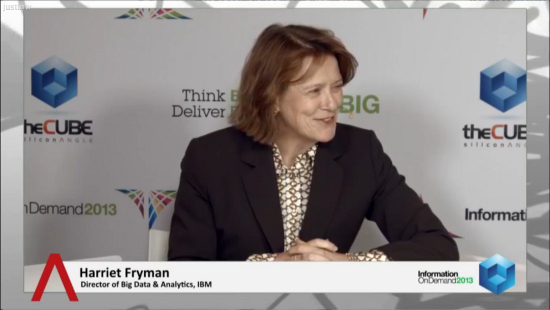 NEWS
NEWS
 NEWS
NEWS
 NEWS
NEWS
![]() Harriet Fryman, Director of Big Data & Analytics at IBM, discussed the company’s Big Data Analytics strategy and approach with theCUBE co-hosts Dave Vellante and John Furrier, live at the IBM Information on Demand 2013 event in Las Vegas.
Harriet Fryman, Director of Big Data & Analytics at IBM, discussed the company’s Big Data Analytics strategy and approach with theCUBE co-hosts Dave Vellante and John Furrier, live at the IBM Information on Demand 2013 event in Las Vegas.
Explaining IBM’s Big Data & Analytics, Fryman explained, “we’ve really looked at the four technology disruptors,” the social move, the mobile – everybody’s mobile, we use analytics to better serve them in their location, cloud – which helps deliver analytics and Big Data wherever the organizations are, and Big Data and Analytics which is the fourth layer that “helps people get the insights they need and help them apply it better in their business.”
All these disruptors are fueling each other, she explained, as “social can be a great source of information that can help fuel and augment what enterprises have inside.”
It is a big fuel source for Big Data and analytics, which in turn can better fuel social interaction. As the world is getting instrumented, the social data adds up to internal data and helps people understand the world around them. Tying that information to structured data yields more insight.
Fryman exemplified with a real-world problem of dropping sales for a given product. Apart from looking at structured data, consulting social data might highlight a competing product people are talking about, allowing the organization to “get the sentiment in the market, tie it to the internal data,” and use that to build reputation or make a real time offer.
“Every business owner and leader that I talk to really knows there’s a value in Big Data, but doesn’t know where that is and where to find it.” Fryman said. “If we’re going to take advantage of that data community out there, we have to think of it dynamically,” in real time. “We see where Big Data and analytics come together the most is real time,” that is why IBM invested in projects such as predictive analytics.
Asked to comment on IBM’s new category, Big Data Analytics, and how the decision was made to approach the marketplace that way, Fryman said “Big Data is like my muscles that don’t go to the gym, they need to be exercised, and it’s analytics that exercises it. We saw the marriage very early on, you need to put Big Data and analytics together.”
Fryman said IBM’s uniqueness comes from their approach focused on outcome of the business. “Clients already have an initial investments, we want to work with what they have and expand their infrastructure to address that business problem and go from there.”
Asked to further define their concept of openness, she said that the company does a number of things in its technology “to make sure we’re open.” That includes large contributions to open source and OpenStack, open APIs, and the general approach of not changing what’s working, but flashing out what companies need to solve a business problem.
Asked to comment on the skepticism of certain CIOs, Fryman said, “I don’t know that waiting is a good approach. The place that we say to start is look for a part in your business that can get a dramatic return on investment. The three focus areas are where they can provide more answers to make better solutions, where they can improve business processes by applying Big Data analytics to the process, and the third one is to develop new business models. An example would be Telcos partnering with retail stores and offer coupons for directly on customers’ mobile devices.
Asked by Vellante why she thought the promise of new business models will be delivered, Fryman said “we’re now seeing analytics in the actual business process systems themselves,” for example providing analytics to drivers for logistics companies – where to stop for rest stops, what routes to take.
“There’s a golden nugget in the data, but we don’t know what the byproduct of the data is,” Fryman explained the current challenges of the industry. “People have become hoarders of the data,” as they don’t have good enough filters to gain insights.
Commenting on the new roles in organizations around data science, Fryman said that “some of the people that are already making it happen are thinking like six-year-olds,” as that is the age where each question is “Why” and eventually children are told “because.” “The people that are constantly questioning” are the innovators in the industry. The people who are really successful break from the “because” answer.
Support our mission to keep content open and free by engaging with theCUBE community. Join theCUBE’s Alumni Trust Network, where technology leaders connect, share intelligence and create opportunities.
Founded by tech visionaries John Furrier and Dave Vellante, SiliconANGLE Media has built a dynamic ecosystem of industry-leading digital media brands that reach 15+ million elite tech professionals. Our new proprietary theCUBE AI Video Cloud is breaking ground in audience interaction, leveraging theCUBEai.com neural network to help technology companies make data-driven decisions and stay at the forefront of industry conversations.